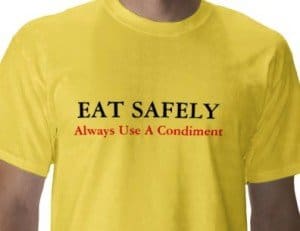Dr Hyman’s 10 Rules to Eat Safely and My Thoughts On What May Stop You

There’s the knowing and there’s the doing. You may know some or all of Dr. Hyman’s “10 Rules to Eat Safely for Life”, but can you do it? We resist change, even if we know the change is good. Here are some thoughts about doing what you know is right, and 10 rules to eat right.
AFTER READING Dr. Mark Hyman’s heat-felt suggestions about “10 simple goof-proof rules for staying healthy for life” (see below), I copied the link and emailed it to someone very dear to me who has struggled all her adult life with obesity.
I wrote this to her:
“I’d guess you’ve read this advice before and will probably agree how huge a change in behavior it would take to implement — from food buying patterns, to food oriented social endeavors, to how one gets nurtured. Anyway, knowledge is power, as is a gun with bullets loaded, but of course, nothing is killed without pulling the trigger.”
(Yes, I could have used a better metaphor.)
Over the years, I’ve had enough conversations with people who want to change some big, entrenched, negative behavior – and they know what to do – but cannot take the steps necessary to make the necessary changes.
Indeed, often times the issue is not knowing what to do, but being able (or willing) to do what’s known.
Who among us hasn’t wrestled with this issue?
I’ve not wrestled with weight problems. The few times I’ve found myself to be a bit overweight relative to my standards, I’ve both known what to do, and have been able to implement what I know.
But being overweight is not the only issue out there, or in me. My issues, and perhaps yours, aren’t as obvious as a jiggling belly, but overcoming them can be just as confusing and arduous.
Because entrenched habits, whether good or bad, are deeply embedded in our life’s patterns and serve a purpose. Strangely, even bad habits reinforce something that we need, or – to put it in another way – something that we believe about ourselves.
Naturally, the specifics are specific to each individual, but some common threads are shared among us.
For instance, a person who feels unloved or not cared for might nurture himself with food and drink. A person who had a deeply negative experience with the opposite gender might allow herself to become obese to minimize the probability to confront such as situation again.
Over time, the behavior that leads to psychological and/or physical issues seems normal; certainly, it becomes entrenched and thus hard to dig out and replace with behaviors that build a different reality.
So, it is with this understanding that I share with you Dr. Hyman’s 10 Rules to Eat Safely for Life (and What to Remove From Your Kitchen).
Remember, although it’s very important to have this knowledge, in order to kill the habits that make you unhealthy, you have to find a way to pull the trigger. If you’ve already accumulated a lot of helpful information, but find that you’re not adopting enough of it, consider how you can do things differently.
Perhaps recruit a friend to take the journey with you, or help guide your trip. Perhaps retain a coach for a short time just to get you on the right path. If you know that you can be influenced by a good book, find one about behavior modification and/or goal setting and attainment.
(Read my Six Tools to Make Your New Year Resolutions Come True.)
And now to my summary of Dr. Hyman’s “10 Rules”. For his original post, go here.
10 Rules to Eat Safely for Life
These 10 simple rules are designed to do several things. If followed, you’ll lose weight, increase vital energy, reduce medication and avoid (or reduce) chronic disease.
As Dr, Hyman says:
“You vote three times a day with your fork and it impacts our health, how we grow food, energy consumption, climate change and environmental degradation. You have more power than you think. Use it!”
1. Food without Labels. Reduce or eliminate foods that come in a box, a package or a can. There are labeled foods that are great, like sardines, artichoke hearts, or roasted red peppers, but you have to be very smart in reading the labels. There are two things to look for: the ingredient list and the nutrition facts. (Check Hyman’s report on “How to Read Labels” for more information.)
2. The Five-Ingredient Rule. If a food has a label it should have fewer than five ingredients. If it has more than five ingredients, throw it out. Also food with health claims on the label are usually bad for you, such as “sports beverages.”
3. Beware Sugar. If any type of sugar is on the label (by any name, including organic cane juice, honey, agave, maple syrup, cane syrup, or molasses) throw it out. There may be up to 33 teaspoons of sugar in the average bottle of ketchup. Same goes for white rice and white flour, which act just like sugar in the body. If you have diabesity — the spectrum of metabolic imbalances starting with just a little belly fat, leading all the way to diabetes — you can’t easily handle any flour, even whole-grain. Throw it out.
(Read The Diabesity Epidemic – It May Be Coming to You)
4. Beware High-Fructose Corn Syrup. Throw out any food with high-fructose corn syrup on the label. This super sweet liquid sugar takes no energy for the body to process, and may also contains mercury as a by-product of the manufacturing process. Many liquid calories, such as sodas, juices, and “sports” drinks contain this metabolic poison. It always signals low quality or processed food.
5. No Hydrogenated Foods. Throw out any food with the word “hydrogenated” on the label. This is an indicator of trans fats, which are vegetable oils converted through a chemical process into margarine or shortening. These fats have been proven to cause heart disease, diabetes, and cancer. New York City and most European counties have banned trans fats, and you should, too.
6. No Highly Refined Cooking Oils. Throw out any highly refined cooking oils such as corn, soy, etc. Also avoid toxic fats and fried foods.
7. No Unrecognizable Ingredients. Throw out any food with ingredients you can’t recognize, pronounce, or that are in Latin.
8. No Preservatives or Additives. Throw out any foods with preservatives, additives, coloring or dyes, “natural flavorings,” or flavor enhancers such as MSG (monosodium glutamate).
9. No Artificial Sweeteners. Throw out food with artificial sweeteners of all kinds (aspartame, Splenda, sucralose, and sugar alcohols — any word that ends with “ol” like xylitol, sorbitol). They make you hungrier, slow your metabolism, give you bad gas, and make you store belly fat.
(Note: There is some debate about xylitol. In my post, Are You Getting Fat and Sick from Sugar, I note that Finnish studies suggest xylitol to be a good sugar substitute.)
10. Eat from the Earth. If it came from the earth or a farmer’s field, not a food chemist’s lab, it’s safe to eat. As Michael Pollan says, if it was grown on a plant, not made in a plant, then you can keep it in your kitchen. If it is something your great grandmother wouldn’t recognize as food, throw it out Stay away from “food-like substances.”
Well, there you have it, some great advice from a medical doctor devoted to understanding and treating the causes of disease, not just their symptoms; and one who has found that one very prevalent cause of chronic disease is the great American diet.
Last Updated on December 5, 2014 by Joe Garma



